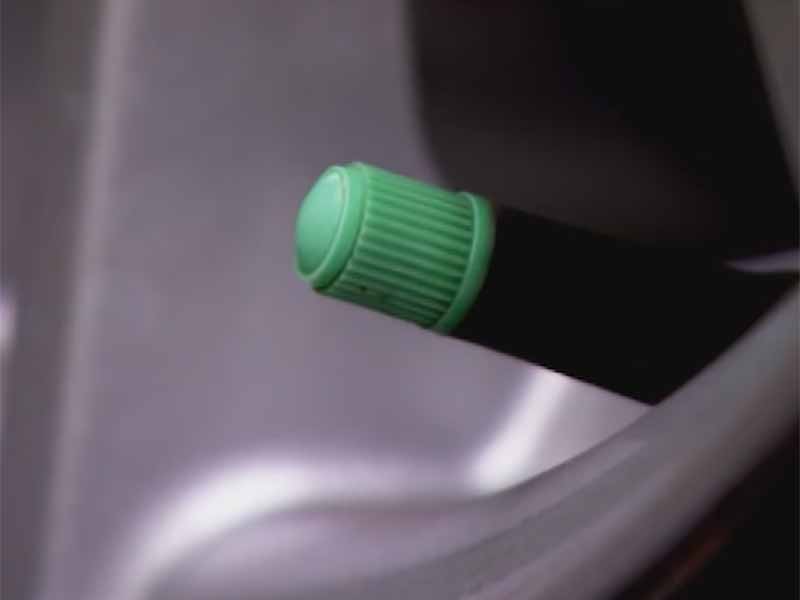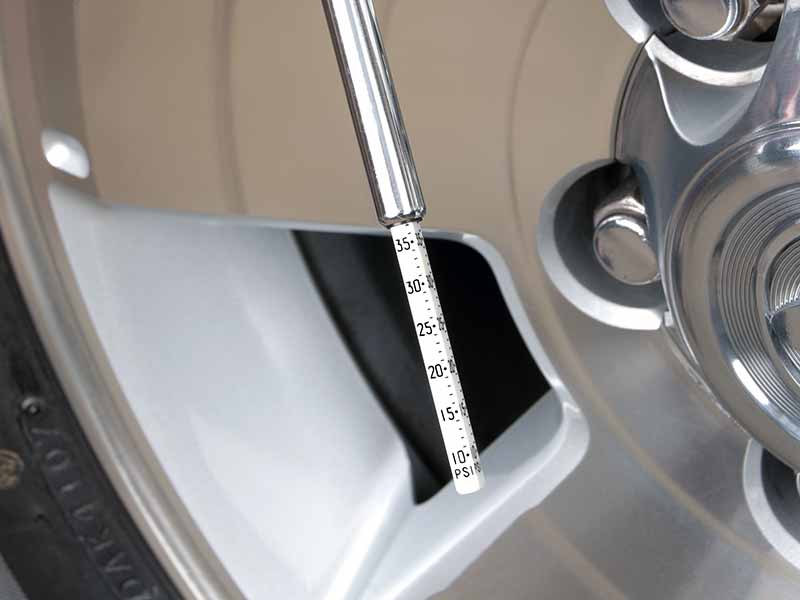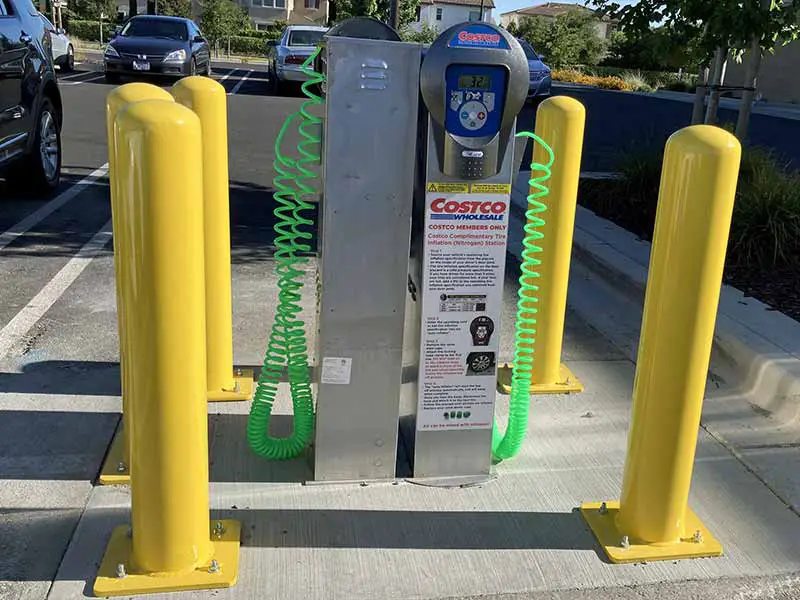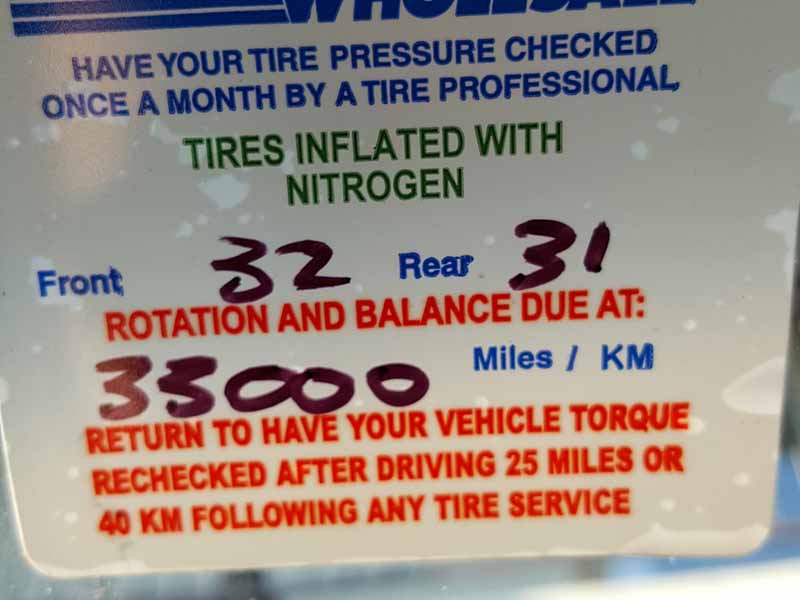The National Highway Traffic Safety Administration (NHTSA) estimates that about 1 in 4 vehicles on the road is driving with at least one underinflated tire. The frequency of checking your tires filled with nitrogen can greatly impact your vehicle’s performance and safety.
How Often To Check Nitrogen-Filled Tires
Nitrogen-filled tires should be checked at least every 3 months, but we recommend checking them monthly.
Compressed air-filled tires should be checked monthly. This also allows you to check your tire tread depth and tire condition, which is a good safety precaution.
In this article, you’ll learn the importance of regularly checking the pressure of your tires, along with helpful background information on their benefits and maintenance. We’ll focus on answering how often to check nitrogen tire pressure and provide valuable insights into how nitrogen can enhance your driving experience.
Let’s take a closer look.

The Benefits Of Nitrogen-Filled Tires
Just to make sure we’re all on the same page, let’s briefly cover the benefits that come from using nitrogen in your tires instead of regular compressed air. These include less air leakage, better gas mileage, better tire life, and safer driving. Let’s learn more about each of these benefits.
Reduced Leakage Rate Compared To Air-Filled Tires
Using nitrogen in your tires has a big advantage over regular compressed air. They leak more slowly. This means the air pressure in your tires will stay more even over time.
Regular air has tiny oxygen molecules that can escape through the rubber. Nitrogen molecules are bigger, so they don’t escape as easily. This helps your tires stay properly inflated for longer.
Improved Fuel Efficiency And Tire Life
When your tires have the right amount of pressure, you’ll get better fuel economy. This is because properly inflated tires have less rolling resistance. Rolling resistance is the force your car has to work against as your tires roll on the road.
Proper tire pressure keeps the shape of your tires correct to contact the road surface as designed. This also will help them wear more evenly and can help your tires last longer.
Enhanced Safety And Reliability
Nitrogen-filled tires can make your car safer to drive. When your tires have the correct pressure, they work better. This means better handling and braking on the road.
Proper tire pressure means the tread makes even contact across the entire width of your tire. Underinflated tires rest more on the shoulders and less on the center of the tread. They also put a lot of stress on the sidewalls since they have to do more work holding your car or truck up since there isn’t enough inflation pressure.

How Often to Check Nitrogen-Filled Tires
Next, we’ll talk about how often you should check the pressure in your nitrogen-filled tires. It’s important to know when to look at your tires, so your car stays safe and works well.
Debunking The 3-Month Myth
Some people think that since nitrogen leaks more slowly than air, they only need to check their tire pressure every 3 months. But this is not a good idea. Waiting that long can cause tire pressure problems, which can make your car less safe and harder to drive.
Recommended Monthly Checks For Optimal Performance
Instead of waiting 3 months, it’s better to check your nitrogen-filled tires once a month. This makes sure your tires always have the right amount of pressure. By checking often, you can help your car drive better and be safer. Remember, even though nitrogen-filled tires lose pressure more slowly, they still need to be checked regularly.
Importance Of Regular Tire Pressure Checks (Even With Nitrogen-Filled Tires)
Even though using nitrogen in your tires is good for people who don’t check their tire pressure often, it’s still important to do it regularly. Regular checks help you get the most out of your tires. So, don’t forget this important step in taking care of your car.
Here’s a short list of benefits that come from maintaining proper tire pressure:
- Improved Fuel Efficiency: Properly inflated tires have less rolling resistance, which helps your vehicle use fuel more efficiently.
- Extended Tire Life: When tires are at the correct pressure, they wear more evenly, resulting in a longer lifespan.
- Enhanced Safety: Proper tire pressure ensures better handling, braking, and traction, reducing the risk of accidents.
- Optimal Performance: Your vehicle’s overall performance, including acceleration and responsiveness, improves with properly inflated tires.
- Reduced Environmental Impact: Improved fuel efficiency and longer-lasting tires contribute to a smaller environmental footprint.
- Lower Maintenance Costs: Proper tire pressure helps prevent premature wear, reducing the need for frequent tire replacements or repairs.

How To Maintain The Benefits Of Nitrogen-Filled Tires
In this part, we will talk about how to keep the good things that come from using nitrogen in your tires. We will learn about topping up with nitrogen, finding the correct pressure, and where to fill your tires with nitrogen. Let’s get started!
Topping Up With Nitrogen Instead Of Air
To keep the benefits of using nitrogen in your tires, it’s important to fill them with nitrogen when they need more air. If you use regular air, the good things about nitrogen-filled tires will be diluted, literally! So, always try to top up your tires with nitrogen when they’re underinflated.
Identifying The Right Pressure For Your Tires
Some people get confused about tire pressure in tires filled with nitrogen. Tires filled with nitrogen have the same required inflation pressure as compressed air-filled tires. They also don’t need a special tire pressure gauge or other specialty tools. The only difference is the gases in the tire.
To make sure your tires have the right pressure, you need to know what the correct pressure is for your car. You can find this information in your car’s owner’s manual or on a sticker inside the driver’s door. Make sure to check the pressure when your tires are cold since the pressure can change when the tires get warm from driving, and the correct pressure is when cold, not hot.
Finding Nitrogen Filling Stations Near You
You might wonder where to fill your tires with nitrogen. Many tire shops, car dealerships, and some gas stations have nitrogen filling stations. You can search online or ask your local tire shop where to find a place near you that offers nitrogen tire filling. This way, you can easily keep your tires topped up with nitrogen and enjoy the benefits they provide.
You may have access to free nitrogen gas if you’re a Costco member. Unfortunately, there doesn’t seem to be a Costco website feature to determine if they have a nitrogen fill station at your local warehouse. You can call your local Costco location and ask.

Resources
Below are some links you may find helpful when learning about tires
- Should you use nitrogen in your car tires? – Consumer Reports
- What are the benefits of nitrogen-filled tires? – Continental Tires
Final Thoughts
Knowing how often to check your nitrogen-filled tires is crucial for enjoying all the great things they offer. Remember, it’s best to check your tire pressure once a month, even though nitrogen-filled tires lose pressure more slowly than regular air-filled tires.
We’ve learned that nitrogen-filled tires can help with fuel efficiency, tire life, and safety. But to get these benefits, it’s essential to maintain the right pressure and top up with nitrogen when needed. By checking your tire pressure regularly and taking care of your tires, you can keep your car running smoothly and safely, making every drive a better experience.
As we’ve seen, it’s not just about having nitrogen-filled tires; it’s about taking care of them too. So, next time you’re near a nitrogen filling station, give your tires a quick check and top them up if needed.
Good luck and happy motoring.





